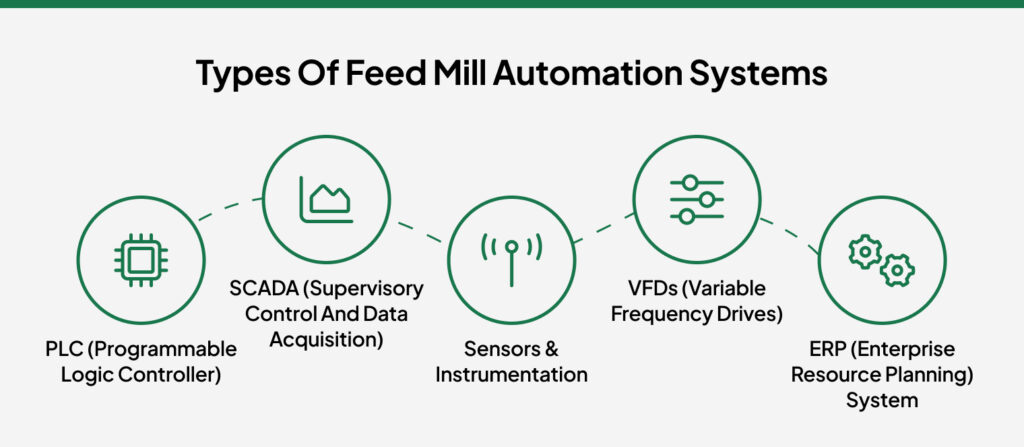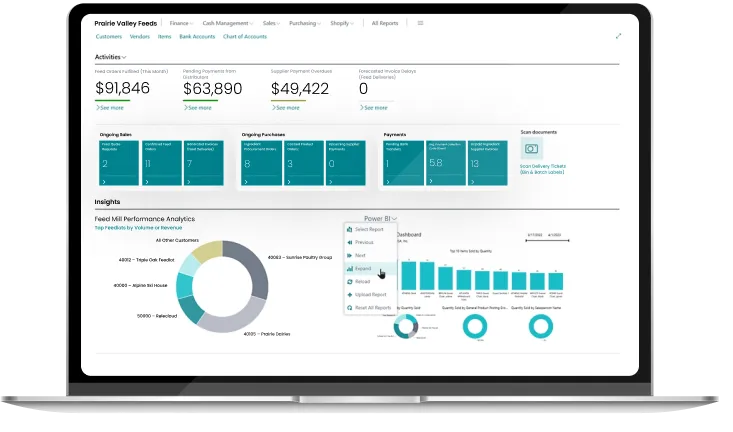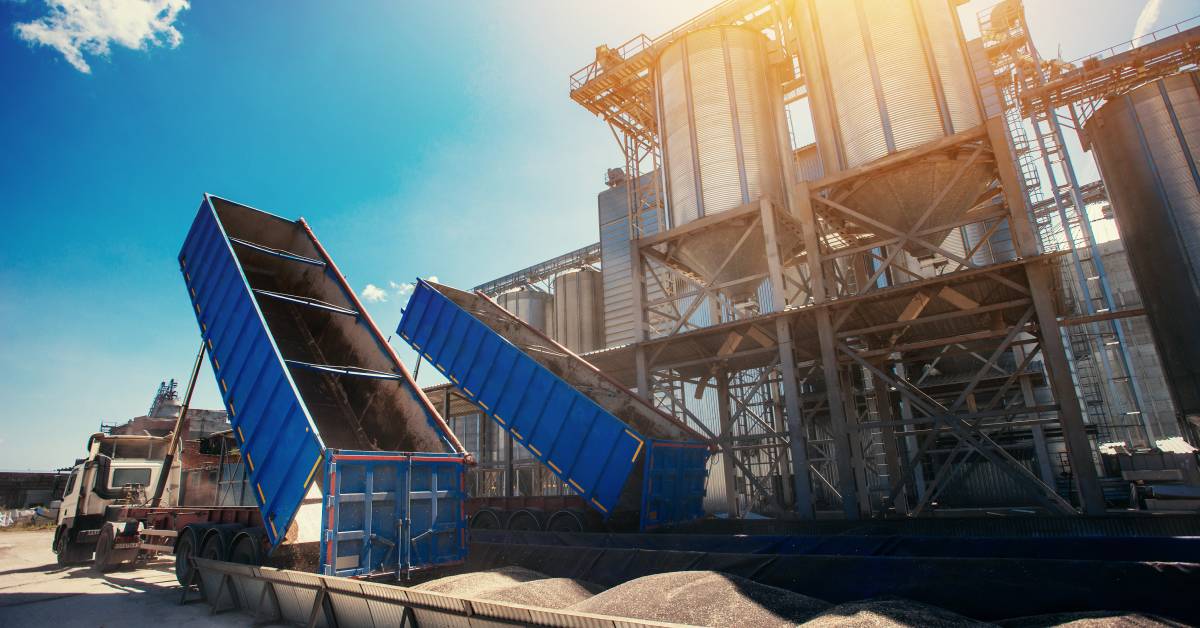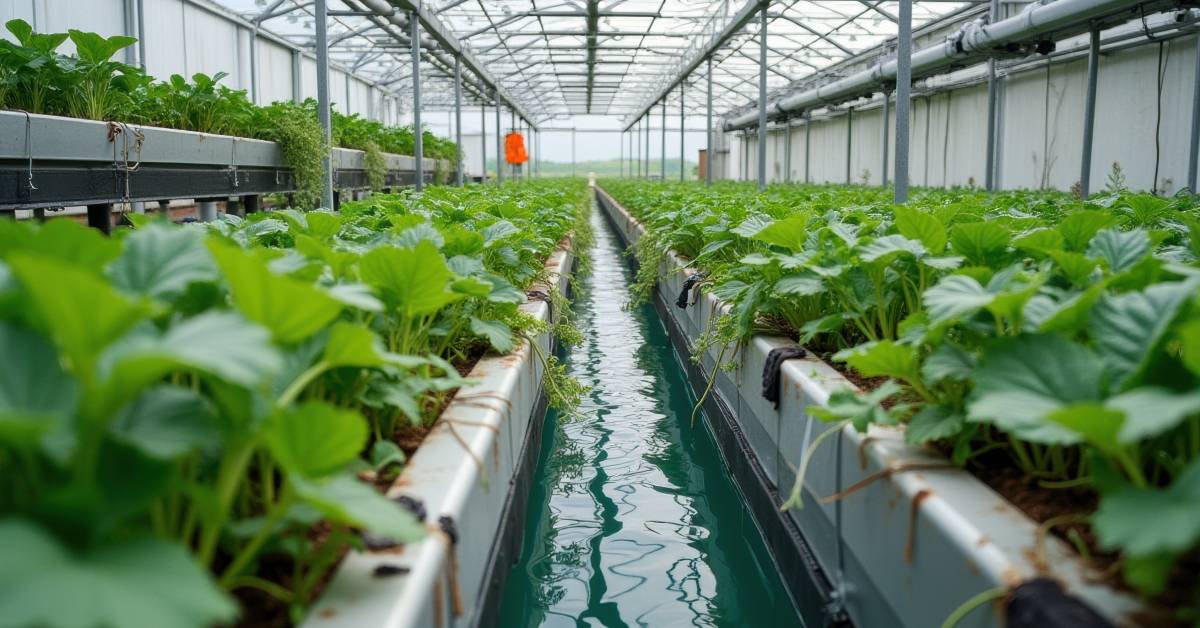In many feed mills, day-to-day operations still rely heavily on manual effort. Operators move between the control room and the shop floor to manage batching, adjust machine settings, monitor ingredient flow, and record data by hand. This setup may work at a small scale, but as production volumes increase or skilled labor becomes harder to find, it starts to show strain. Mistakes in batching, delays in production, and raw material losses become more common and more costly.
Feed mill automation is designed to solve these challenges by bringing key processes under one centralized system. It allows teams to monitor, control, and adjust grinding, mixing, pelleting, and loadout from a single interface. It also improves accuracy, flags issues early, and reduces the need for constant manual checks.
In this blog, we’ll look at what feed mill automation actually means inside a feed mill, which areas see the most impact, and how to plan for automation as a long-term operational improvement, not just a one-time upgrade.
Why Automation Has Become Essential for Feed Mills
Many feed mills are reaching a point where manual systems just aren’t enough. For example, Smithfield’s feed mill in Milford, Utah, was producing over 12,000 tons of feed per week, but its processes were still dependent on relay-based controls and operator-managed batching. This led to inconsistent feed quality, delays in troubleshooting, and high operator workload. By upgrading to a hardware and software-based automation system, they improved batch management and got real-time visibility into feed production.
It wasn’t just a tech upgrade; it solved real operational issues holding them back. What we’re seeing across the industry is a similar shift. Automation is no longer a “nice-to-have.” It’s becoming necessary to run a reliable, efficient feed mill. Input costs are volatile, regulations around traceability are stricter, and it’s getting harder to find and retain experienced operators.
Here are a few reasons why feed mill automation is now becoming critical for businesses:
Nutritional Precision and Consistency
Every animal feed batch must meet specific nutrient targets, whether it’s protein for grower pigs, energy levels for finishing cattle, or floating stability in aquafeed. Missing those targets, even slightly, can affect weight gain, feed conversion, or animal health outcomes. Manual batching often results in ingredient overuse or underuse, especially with micro-additives like amino acids or premixes, leading to inconsistent feed quality and inefficiencies in cost per ton.
With the help of feed mill automation, precise weighing and dosing are possible for every batch. Through automated micro-batching systems, feed mills can consistently hit target nutrient levels, reduce formulation errors, and maintain uniformity across shifts. This consistency not only supports animal performance but also improves customer trust and reduces product recalls due to off-spec feed.
Input Costs Are Rising, and Automation Reduces Waste
With prices for corn, soybean meal, and other key ingredients fluctuating, even small losses during batching, grinding, or transfer can add up fast. Manual overfills, spillage, or improper sequencing often go unnoticed until the material is gone.
Feed mill automation reduces this waste by controlling flow rates, monitoring bin levels, and enforcing batching limits. Systems track every ingredient used and flag deviations immediately. For example, automated batching can prevent costly overdosing of high-value additives like enzymes or amino acids, protecting margins without compromising formulation quality.
Cross-Contamination Risk Requires Strict Sequencing & Cleaning Logs
Feed mills producing medicated and non-medicated feeds, or feeds for different species, must follow strict sequencing to prevent cross-contamination. Manual tracking of flushes, sequencing, and cleanout steps often results in missed steps or poor recordkeeping.
Mill automation enforces proper batch sequencing and logs each cleanout cycle automatically. It ensures that flush material is used at the right time, proper downtime is applied, and audit trails are complete. This is especially critical for mills under VFD regulations or HACCP-based programs, where traceability and compliance are non-negotiable.
Energy Optimization During Grinding
Grinding is one of the most energy-intensive steps in feed production, especially when particle size must meet specific specs for poultry, swine, or aquafeed. Yet, with even modest adjustments, such as adding VFDs or automating load control, mills can reduce energy consumption by 5%, according to Feed & Additive. With a more strategic investment in plant-wide automation, energy savings can reach up to 20%.
These feed mill automation systems adjust motor speeds, feeder rates, and screen settings in real time based on material type and required particle size. Over time, this not only cuts power bills but also extends equipment life and maintains consistent throughput.
Types of Feed Mill Automation Systems That Keep the Mill Running
Feed mill automation isn’t just one system; it’s a set of technologies working together to keep production steady and predictable. Some handle real-time equipment control, others track inventory, and some connect plant operations with business systems. Knowing what each one does helps you decide where to start or where to improve your feed mill process.
Below are the core automation systems most feed mills rely on today:

1. PLC (Programmable Logic Controller)
In most feed mills, PLCs are what keep machines doing what they’re supposed to, without needing someone to stand over them. Once set up, they run the equipment based on simple logic: open this gate when the scale hits target weight, stop the mixer after 90 seconds, start the conveyor when the bin’s ready. They don’t make decisions, they follow the rules you give them. But when you’re dealing with high volumes and limited staff, that kind of predictable control becomes essential for feed mill automation.
What PLCs typically manage in a feed mill:
- Opening and closing ingredient gates during batching
- Starting and stopping motors for mixers, hammermills, and conveyors
- Switching between bins or silos based on routing logic
- Running sequencing rules for flushing and cleanout
- Triggering alarms when something goes off-spec, like a stuck gate or overload
2. SCADA (Supervisory Control and Data Acquisition)
If PLCs are doing the hands-on control, SCADA is the system that lets you see what’s happening, spot problems early, and make adjustments without walking the entire plant. It pulls live data from equipment across the mill, batching, mixing, pelleting, grinding, and brings it all into one screen for operators or managers. Instead of relying on guesswork or clipboard logs, SCADA shows you where things are running smoothly and where attention’s needed.
In a feed mill, SCADA systems typically help with:
- Live monitoring of equipment status, flow rates, and ingredient weights
- Remote start/stop of systems from a central control room
- Alarm notifications when something goes off-target
- Historical data trends for troubleshooting and performance analysis
- Logging batch records automatically for compliance or internal audits
3. Sensors & Instrumentation
Sensors are the eyes and ears in feed mill automation. They gather data from each stage of production, from moisture levels in raw grains to the amperage drawn by pellet mills. This real-time data feeds into PLCs and SCADA systems, enabling better control, early fault detection, and tighter process consistency. Without reliable sensors, automation can’t function effectively.
Common types of sensors used in feed mills:
- Load cells: Monitor weight in batching and mixing operations
- Temperature sensors: Ensure proper conditioning and pelleting temperatures
- Moisture sensors: Maintain target moisture levels in mash or finished pellets
- RPM and vibration sensors: Detect abnormal motor or gearbox behavior
- Level sensors: Track inventory in bins and hoppers
Modern instrumentation helps mills optimize quality and reduce waste by detecting problems before they escalate, which is essential when margins are tight and consistency is non-negotiable.
4. VFDs (Variable Frequency Drives)
VFDs give you control over how fast your motors run, which matters more than most people think. Equipment like hammermills, conveyors, and pellet mills doesn’t always need to run at full speed in feed mills. With VFDs, you can adjust motor speed based on load, material type, or process stage. That means smoother operation, less wear on equipment, and lower power bills.
Where VFDs are commonly used in feed mills:
- Hammermills: Adjust speed based on grain type or screen size
- Augers and conveyors: Prevent surges, backups, or material bridging
- Pellet mills: Fine-tune die speed for better pellet quality
- Fans and blowers: Manage airflow in coolers or dust systems
- Mixers: Control mix speed for better consistency and reduced spillage
5. ERP (Enterprise Resource Planning) System
While PLCs and SCADA manage the shop floor, a feed mill ERP system connects the rest of the business, from procurement to inventory, production planning, QA, and sales. In a feed mill, ERP acts as the central system for tracking raw material intake, managing recipes and formulations, coordinating production schedules, and monitoring delivery and invoicing.
Key functions ERP systems perform in feed mills:
- Raw material traceability from suppliers to finished feed
- Recipe and batch control with integrated nutrition specs
- Inventory visibility across ingredients, packaging, and finished goods
- Production costing and analytics to track margins in real time
- Compliance support with audit trails and digital logs
What Feed Mill Processes Are Best Suited for Automation?
In most feed mills, full feed mill automation isn’t necessary across every function, but there are certain areas where manual work creates challenges and leads to inconsistent output. These are typically processes that require high accuracy, run on tight timelines, or depend on strict sequencing.
Targeting these areas for running a fully automated mill reduces manual corrections, limits material waste, and helps maintain production flow even with a smaller team. It also ensures that major steps, like batching accuracy or flush sequencing, are executed the same way every time. Below are the key processes where automation consistently delivers the highest value.
| Process | What Can Be Automated | Operational Benefits |
| Intake & Receiving | Ingredient identification, weighing, sampling, and unloading logs | Ensures accurate inventory tracking and avoids contamination from mislabeled loads |
| Grinding | Feeder control, motor load monitoring, and screen change alerts | Reduces energy use, prevents overgrinding, and extends equipment life |
| Batching | Formula handling, ingredient dosing, and scaling | Improves nutritional precision and recipe compliance |
| Mixing | Timing control, sequence automation, interlock checks | Enhances mix uniformity and reduces operator error |
| Pelleting | Temperature control, die speed, and fat/oil application | Maintains pellet quality and production waste |
| Cooling | Airflow control, product temp sensing, residence time logging | Prevents condensation and ensures proper pellet stability |
| Load-out | Routing, bin assignment, truck ID integration | Reduces misloads and enables traceability |
| Cleaning & Sequencing | Flush tracking, CIP systems, and allergen changeover logs | Minimizes cross-contamination risk and ensures compliance with QA standards |
| Inventory Management | Real-time bin levels, auto reordering, expiry alerts | Prevents stockouts and improves formulation planning |
How Folio3 AgTech Feed Mill ERP Helps You Automate and Grow
Folio3 AgTech’s Feed Mill ERP connects your shop-floor automation with business operations, turning data into action across the mill. It integrates with hardware systems to feed in real-time production data, enabling precise batch control and inventory oversight at scale. Mills using similar feed mill automation systems have seen immediate gains in recipe accuracy and visibility, speeding up operations while maintaining quality compliance.

The solution offers four practical capabilities:
- Batching & Formula Management
Manage formulations with version control, integrated micro-ingredient dosing, and instant compliance logging, reducing human error and ensuring recipe consistency. - Inventory & Bin-Level Tracking
Live monitoring of ingredient bins and finished product silos. ERP detects stockouts early, triggers reordering, and prevents real-time overloading or feed shortages. - Traceability & Compliance Tools
Every batch is digitally logged, including ingredients, processing steps, equipment used, and quality checks. Similarly, technologies like AI voice cloning rely on precise data tracking and automation to deliver consistent, high-quality output, showcasing the broader importance of traceability and system accuracy in modern digital operations. This ensures audit readiness, quick recall execution, and improved day-to-day compliance. - Production Analytics & Planning
The ERP uses historical data to forecast ingredient needs, schedule production shifts effectively, and monitor margin performance per batch, guiding decisions that reduce waste and improve output efficiency.
Together, these features create a connected, innovative feed mill automation system that reduces manual dependencies and improves operational predictability. With a centralized system, operators gain full visibility and control from raw material intake to final feed dispatch.
Conclusion
Most feed mills aren’t performing well because of poor equipment; they’re held back by systems that can’t keep pace with today’s production demands. When batching is manual, ingredient loss goes unnoticed, or cleanout steps aren’t logged, problems build quietly until they affect output or compliance. Feed mill automation doesn’t solve everything, but it gives mills the ability to track what’s happening, respond faster, and reduce avoidable errors where it matters most.
For many, the right starting point isn’t full-scale feed mill automation; it’s targeting a few high-friction areas like dosing accuracy, flush tracking, and inventory visibility. These changes don’t just make operations cleaner; they make them more predictable. As feed volumes grow and pressure on margins increases, mills need systems that can scale without adding more complexity. Automation gives you that structure, so your team can stay focused on production without running on a chance.
FAQs
What Is Feed Mill Automation, and How Does It Benefit My Business?
Feed mill automation replaces manual control with logic-based systems for batching, routing, and quality checks. It reduces operator dependency, ensures tighter recipe adherence, and keeps production moving even during labor gaps or raw material fluctuations.
How Can Feed Mill Software Help Automate Processes?
Feed mill software links production data (from PLCs, sensors, VFDs) with formulation logic and inventory. It automates task sequencing, logs compliance steps in real time, and provides actionable alerts, allowing faster issue resolution and fewer process hold-ups.
What Are the Key Processes in Feed Mills That Should Be Automated?
Start with operations prone to error or delay:
- Intake validation to catch misidentified loads early
- Grinding control to match particle specs by species
- Batch sequencing to prevent cross-contamination
- Flush tracking for VFD and medicated feed compliance
These directly impact efficiency, safety, and formulation accuracy.
What Technologies Drive Feed Mill Automation?
Critical systems include:
- PLCs for local logic execution
- SCADA for centralized monitoring and diagnostics
- Load cells, level, and moisture sensors for accurate input/output control
- VFDs for optimizing motor loads and reducing peak power use
- ERP platforms to unify production data with costing, traceability, and shift planning
Each layer enhances system responsiveness and cuts avoidable losses.







